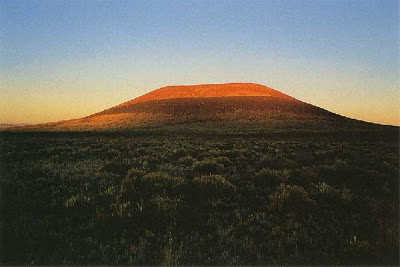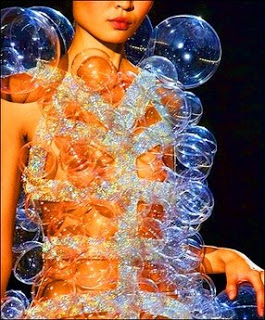Whitney Biennial 2008
Art Vent Letting the Fresh Air In
 Alberto Giacometti, Full Figure III (1960), Museum of Modern Art
Alberto Giacometti, Full Figure III (1960), Museum of Modern ArtI also didn’t get William Kentridge—but only because I hadn’t yet seen the MoMA retrospective, having been put off by the overwhelming hype (he’s definitely the artist of the year) which is not a good excuse. I left awed, especially by the miniature theater representation. I’m still kicking myself for not seeing “The Nose” (I hated the name—have got to revise my attitude), which my smarter friends told me was an amazing theatre experience. Sometimes things are famous for a reason.
Next was the Whitney Biennial, which has to be the blandest yet. After the bustling scene at MoMA, the Whitney seemed tired, wan, past its prime (there was a time when it was the other way around). Yes, there was a desultory queue to get in—it was Good Friday after all—but the galleries themselves were hardly crowded, the visitors wandering around with a “Why am I here?” look on their faces. I am, however, pleased to report that the video has been installed in such a way that it doesn’t distract from the static pieces and, unlike previously, I can’t have fun with the publicity material: this year the descriptions of art and artists are sensible, even readable. There’s no blurb for Charles Ray, however—did he request that there not be one, or have they just not gotten around to it?
I also went to the National Academy Museum’s annual invitational exhibition, and am beginning to feel that the whole survey show concept is so last century (or maybe the one before that—this is the 185th for the NAM). Perhaps the “Biennial problem,” its loss of relevance with each permutation, has not only to do with the Whitney’s choices, but that if one is seeking a true art experience, any exhibition where the work isn’t related through some over-arching theme feels increasingly like a waste of time.
The Biennial is the subject of David Cohen’s usually perky Review Panel on April 23rd, and I’m curious to see if three interesting critics (Roberta Smith, Christian Viveros-Faune, and
Svetlana Alpers) can be interesting enough to make the subject of uninteresting art interesting.
 James Turrell's Roden Crater
James Turrell's Roden CraterHowever along with deconstruction, we lost our ability to discern. We went rollicking off in the other direction, making deconstruction an excuse for sloppy thinking, sloppy execution, sloppy everything. And I lay much of the blame for this on the proliferation of art schools who profit by making everybody think art is easier than it is, who in order to exist, need the majority of students to come away with a positive experience. I remember a final graduate crit at SVA, when I said to a student about her sculpture, “There’s a lifetime of work to be mined from this”—thinking that I was giving her my highest praise—and she burst into tears because to her mind, she was finished. This was it. What, she’d have to do more?
However I believe the resounding failure of the Whitney Biennial marks the beginning of the end of a too-long era. It goes along with the political scene. We want substance. As with the Iraq war, SUVs, and Froot Loops, we’re not inclined to think something is good for us just because the powers that be say it’s so. I’m encouraged by the fact that I’ve seen more good art in the past six months than in the last ten years put together—and that we’re having these conversations. Before when I saw stuff like Fritz Haeg's Animal Estates or the Whitney’s publicity I thought that I was the only one who thought it was ridiculous. It’s a relief to learn that I’m not alone.

Anonymous is so right, it's almost word-for-word. But you have to grit your teeth to watch it.
And "Spatula", commenting on Haeg's Animal Estates admittedly treads on the “dangerous terrain of discourse” in wondering how it can be construed as art, but I will take it on. My definition of “art”—since Duchamp made sure that it can be anything, which to my mind, was a necessary step—is something where execution and idea merge so completely that we’re unaware of either and taken to a place beyond words. That’s what music does for me (thank you, Jose Gonzalez, who I saw at the Iron Horse in Northampton last night) and that’s what I want art to do. That’s what I get from Olafur Eliasson’s endeavors: a place of new experience. Indescribable. Therefore, when I see something that sends my thought processes away from the piece at hand, when instead of being immersed in it I'm congratulating myself for having been so precocious as to realize—even in Mrs. Egbert's first grade— that it was stupid to go around in a group pretending to be squirrels, then it’s not art.
which was inspired by this (after a brief commercial):
Do share your thoughts.
 Bruce Nauman, Double Poke in the Eye II, 1985, neon construction, Kemper Museum of Contemporary Art, Kansas City, Mo.
Bruce Nauman, Double Poke in the Eye II, 1985, neon construction, Kemper Museum of Contemporary Art, Kansas City, Mo.The anti-intellectual label is easily hurled, as is the accusation that anyone who suggests that ideas might be rendered in a readable and understandable manner is somehow calling for a “dumbing down.”
So when Hrag Vartanian states, “If the ideas are complex it is because they often grapple with concepts that resist simplification,” I insist on distinguishing between "simplification" and "clarification." It is not necessary to simplify in order to clarify. Further, I'm suspicious of any idea that can’t be clarified.
What I’m calling for is not a “dumbing down” but a “smartening up.” I’m asking for readers of the fatuous phrases that litter artists’ statements, press releases, and museum text not to swallow them whole, but ask themselves: “What is this really saying?” “Does it make sense?” And more, “What does it have to do with the art at hand?”
In an email, Janice Gewirtz, a reader of the Wall Street Journal, thanks me for my criticism of what she coined the “Emperor’s New Biennial” and says, further, “These overblown installations say nothing cogent about the subjects they ostensibly tackle. Rather, they reference ‘pop culture,’ or ‘sexuality,’ or even the notorious ‘fluid communication structures’ (whatever that is) as buzzwords.”
Exactly. That's what I was referring to in my posts here and here about Doris Salcedo’s crack in the floor of London’s Tate Modern, which is billed as “addressing a long legacy of racism and colonialism that underlies the modern world.” Sometimes a crack is just a crack.
Idly Googling “artspeak” the other day (procrastination is a wonderful thing), I came across an essay by John Haber, written in 1997, where he nails the origin of this language:
…am I imagining it, or do they blend together—the gallery press release and a parody of management jargon?…. It may have its roots in academia, where scholars hope to share their hesitant insights with students and peers. It may look back to art journals, where critics fumble for words to describe works of art rich in emotions and ideas. However, that is not where artspeak begins, and complaints about it hide its origins all too well.
Worse comes to worse, academics will trip up on their own humanity. Worse comes to worse, they will stumble on insights as unfamiliar and unpronounceable as art itself. Artspeak really starts sometime later, when critical clichés pass through the gallery system and into the marketing departments of major museums, eager for a larger public and bigger institutional gifts.
Promoting art is business, big business, and money talks. I call its language martspeak.
So perhaps now that it’s been defined for us--the language of two industries, academia and the art market, who have joined together for their mutual economic benefit--when we see it, we'll more easily recognize martspeak for what it is.
Haber continues:
Words never contain a work of art. Words can, though, encourage its reconstruction. They can create small openings in the walls that already exist, so that others may begin to look—and to see….
Art asks one to enter into a broken conversation, a half-overheard dialog between the work and the world. Newcomers to art distrust that demand. Most, often, too they would never know how to begin. A critic’s job is to break the ice.”
Something that all of us who write about art—be it our own or that of others—would be wise to remember.
 ...Thomson's inherently conversational practice both gamely Pop-ifies its often antiaesthetic historical precedents and resituates that generation's thought experiments in the social realm. (Suzanne Hudson on Mungo Thomson)
...Thomson's inherently conversational practice both gamely Pop-ifies its often antiaesthetic historical precedents and resituates that generation's thought experiments in the social realm. (Suzanne Hudson on Mungo Thomson) 
Short of requiring by law that all wall texts be written in haiku—try cramming “problematize” into that little compartment—I’m not sure what can be done about this….Here might be a modest way to start. Let whoever edits museum catalogues—does anyone edit them?—ban just these five words, which are arranged into rhetorical daisy chains in every other catalogue I see.
1. Interrogates
2. Problematizes
3. References (as a verb)
4. Transgressive
5. Inverts
To those I would add “juxtaposition” and “informed” as in “his work is informed by…”
You are free to add your own.
Why is so much curatorial writing so dreadful? Why is it so clogged with the decrepit formulations of academic artspeak? Why does so much of it sound like it was written by an anxious schoolkid delivering a labored term paper?
My first assumption is that there’s a generation of curators who went to college and grad school in the 1980s and ‘90s, when the congested language of Deconstruction, Critical Studies and so on still seemed important, intrepid, and even a little glamorous. I get the impression that even if a budding art writer wasn’t fully committed to those lines of inquiry, the incredibly turgid writing they produced infected the academy in all directions.
But the industrial strength rhetoric of so much museum writing is also, I suspect, a defense against anxiety by curators and catalogue essay writers afraid to simply say out loud and in plain English what they suppose the work might be getting at. What if they get it wrong? Better to fall back on clichés that stand in for thought without furthering it.
Finally bad writing is just insider talk. It’s not directed to the public at all, but pitched to the coterie of other curators and academics who use jargon to signal to one another their initiation into the world of…jargon.
Read complete article
Richard Lacayo in TIME on the Whitney Biennial